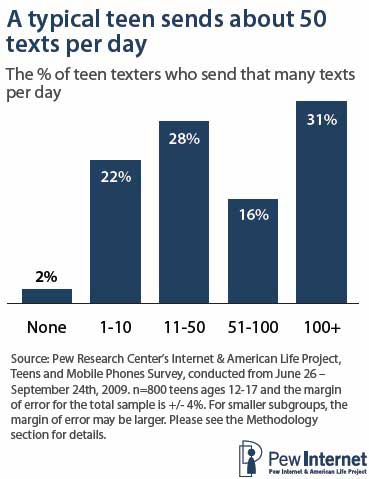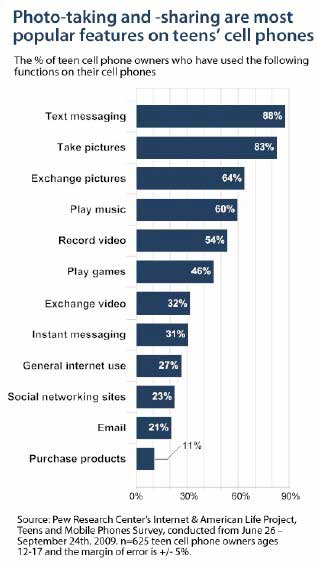Cell-phone texting has become the preferred channel of basic communication between teens and their friends, although calling is a close second: 54% of teens say they sent and received text messages daily in September 2009, up from the 38% some 18 months earlier, according to a survey from Pew.
Three-quarters of teens age 12-17 (75%) say they own a cell phone, including 58% of those age 12, 73% of those age 13, and 83% of those age 17.
Among teens who own a cell phone, 88% say they send and receive text messages, a sharp increase from the 51% of teens who were texters in 2006.
Among those texters today:
- 47% send 50+ text messages a day, or more than 1,500 messages a month.
- 31% send 100+ text messages a day, or more than 3,000 a month.
- 15% of teens who are texters send more than 200 texts a day, or more than 6,000 a month.

Below, other findings from the survey Teens and Mobile Phones, issued by the Pew Research Center's Internet & American Life Project.
Texting More Popular Among Girls
Nearly eight in ten girls (77%) say they send text messages, compared with 68% of boys.
Older teens are also more active: 77% of those age 14-17 say they text, compared with 61% of those age 12-13.

Boys typically send and receive 30 texts a day, compared with girls' 80 messages. Girls age 14-17, however, typically send 100 or more messages a day.
Overall, girls more fully embrace most aspects of cell-phone communications:
- 86% of girls say they text message friends several times a day, compared with 64% of boys.
- 59% of girls call friends on their cell phone every day, compared with 42% of boys.
- 59% of girls send text messages several times a day to "just say hello and chat," compared with 42% of boys.
- 84% of girls have long text exchanges on personal matters, compared with 67% of boys.
- 76% of girls text about school work, compared with 64% of boys.
Among all teens, texting is used for myriad reasons, including communicating with friends and family (95%), reporting locations (89%), and coordinating meetings (85%).

Teens also use texts to exchange information privately (75%) in situations where voice calling would be inappropriate or unwise.
Using the Cell Phone for Calling
Calling is still a central function of the cell phone for teens, and for many of them voice is the primary mode of conversing with parents: 68% of teens with cell phones say they talk to their parents on their cell phone at least once a day.
Overall, however, teens typically make and receive five calls a day—far fewer than text messages.
Some notable differences in voice-call use among teens across ethnicities include the following:
- White teens typically make or receive four calls a day, or around 120 calls a month.
- Black teens exchange seven calls a day, or about 210 calls a month.
- Hispanic teens make and receive five calls a day, or about 150 calls a month.
Other Phone Functions
Beyond text messaging and voice calling, teens who have multipurpose phones say they use many of the extra features. Among the most popular are taking (83%) and exchanging (64%) pictures:

Looking for great digital marketing data? MarketingProfs reviewed more than 200 research sources and selected 64 of the best to create the Digital Marketing Factbook a 144-page compilation of data and 110 charts, covering email marketing, search engine marketing, and social media. Also check out The State of Social Media Marketing, a 240-page original research report from MarketingProfs.
Unlimited Texting Plans Increase Phone Use
Fully three-quarters of teen cell-phone users (75%) have unlimited texting plans, while just 13% have a pay-per-message plans.
Unlimited plans are connected to increases in use: Teens with unlimited texting typically send and receive 70 texts per day, compared with 10 texts a day for teens on limited plans and 5 texts a day for teens who pay per message.
Most teen cell phone users (69%) have a phone that is part of a contract covering all of their family's cell phones, while 18% are part of a prepaid or pay-as-you-go plan and just 10% have their own individual contract.
Among teens who pay for their own phones, 73% say they send text messages several times a day, compared with 65% of teens whose parents pay for their phone and 55% of teens who pay for part of their phone.
Other findings:
- Most schools treat the phone as a disruptive force that must be managed and often excluded from the school and the classroom, yet 65% of cell-owning teens at schools that completely ban phones still take their phones to school every day.
- To some extent, cell phones help bridge the digital divide by providing Internet access to less-privileged teens: 21% of teens who do not otherwise go online say they access the Internet on their cell phone, and 41% of teens from households with annual income of less than $30,000 say they go online with their cell phone.
- Parents and teens say phones make their lives safer and more convenient, yet both also cite new tensions connected to cell phone use: 94% of parents and 93% of teens with cell phones agree with the statement "I feel safer because I can always use my cell phone to get help," but 54% of text-using teens have received spam or other unwanted texts and 26% have been bullied or harassed through text messages and phone calls.
About the data: The Pew Internet survey is based on telephone interviews with a nationally representative sample of 800 US teens age 12-17 and their parents, as well as nine focus groups conducted in four US cities in June and October 2009 among teens age 12-18. The survey was conducted by Princeton Survey Research Associates International.



